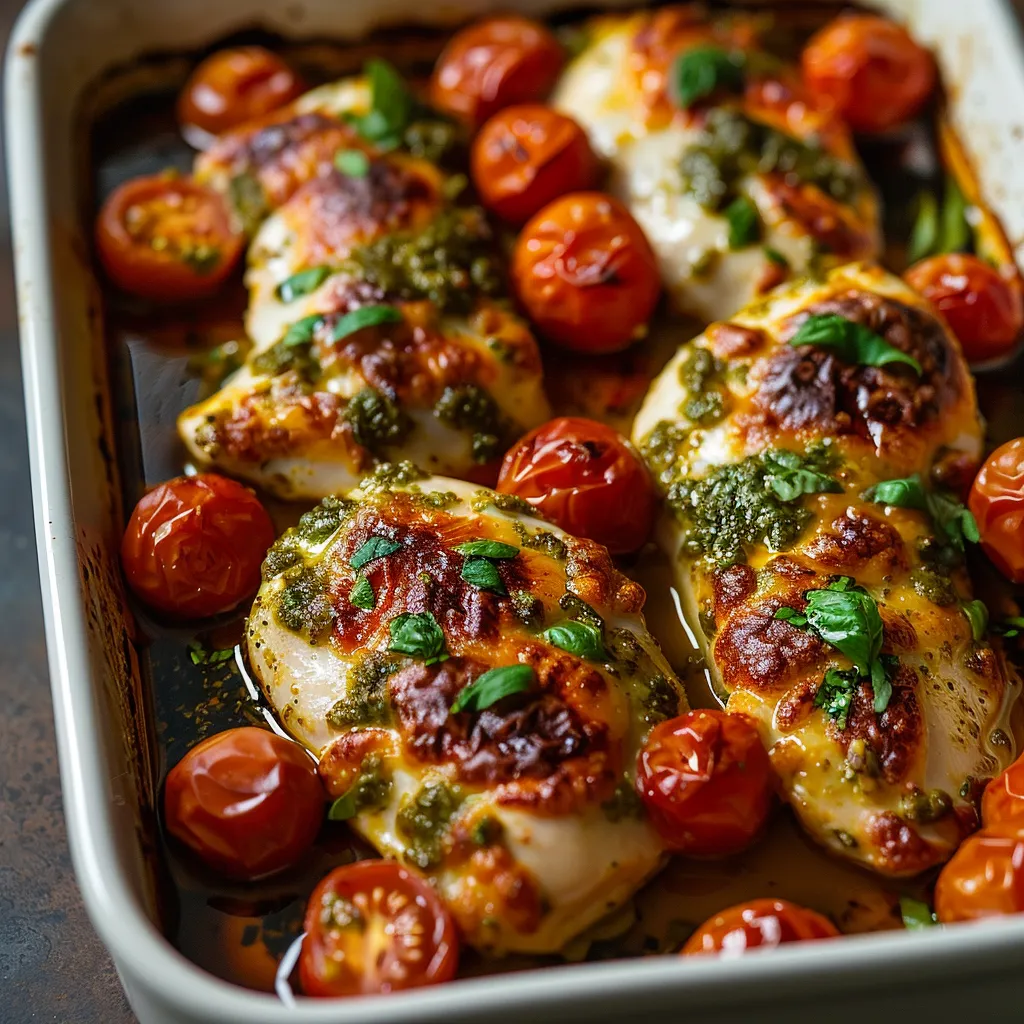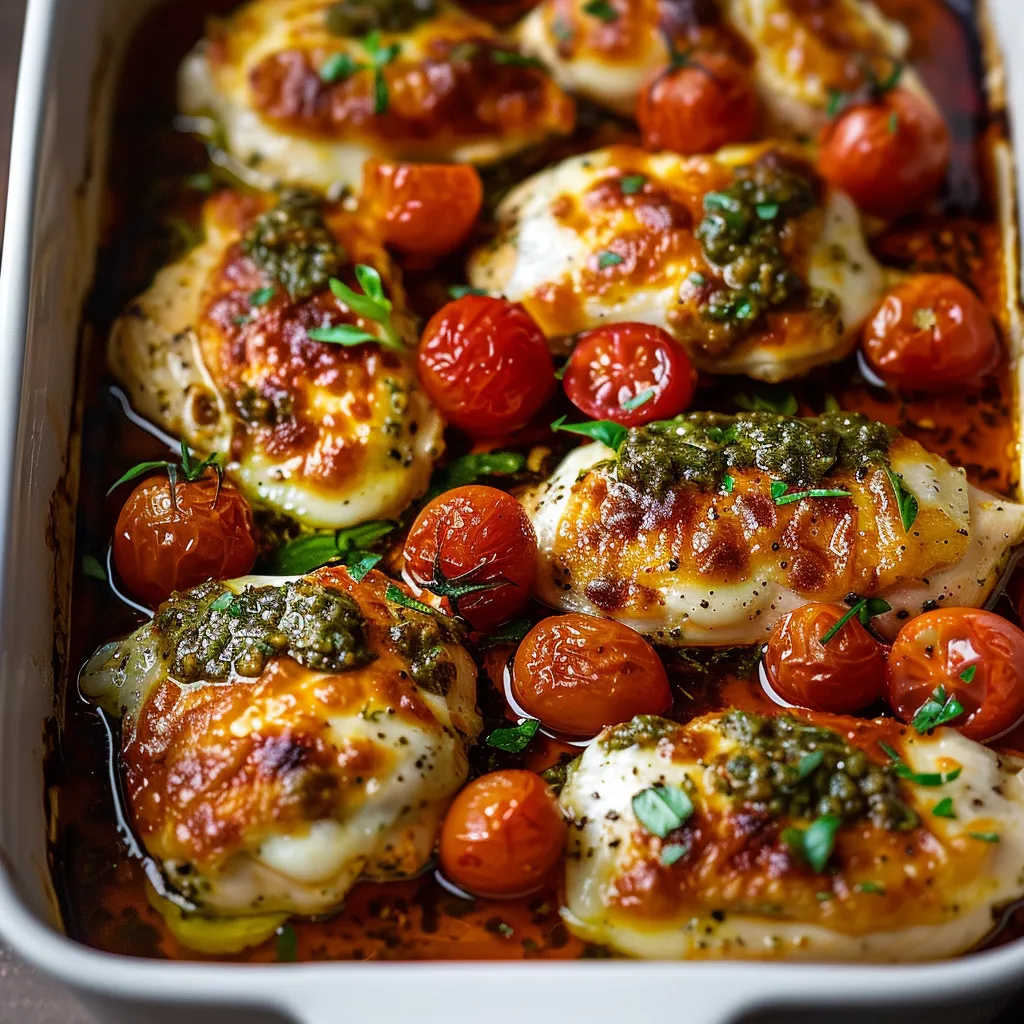 Pin it
Pin it
Juicy chicken breasts nestled among burst tomatoes swimming in pesto sauce and topped with molten mozzarella creates weeknight magic that looks fancy but requires minimal effort. This one-pan wonder delivers vibrant summer flavors year-round with the perfect balance of tangy tomatoes, aromatic basil pesto, and gooey cheese that transforms ordinary chicken into something truly special.
The first time I made this for my family, the kitchen filled with an aroma that brought everyone running before I could even call for dinner. My teenage son, normally reserved with compliments, asked if we could have it again the following night. The combination of roasted tomatoes breaking down into their own sauce, fragrant pesto, and bubbling cheese creates something almost magical that transcends its simple ingredients.
Essential Components
- Cherry tomatoes: Choose ripe, firm varieties with vibrant color for best flavor as they form the foundation of your sauce
- White wine vinegar: Adds necessary acidity to balance the richness of pesto and cheese
- Butter: Creates silky texture in the sauce while adding rich flavor dimension
- Basil pesto: Fresh homemade offers brightest flavor but quality store-bought works wonderfully
- Fresh garlic: Minced just before using provides aromatic complexity impossible to achieve with pre-minced
- Fresh basil: Adds bright, herbaceous notes that elevate the entire dish
- Mozzarella cheese: Freshly shredded melts more evenly than pre-packaged varieties
I discovered through experimentation that using multicolored cherry tomatoes creates not only visual appeal but subtle flavor variations throughout the sauce. My garden produces abundant basil during summer months, making homemade pesto possible, but I keep quality jarred versions on hand for winter cooking when fresh herbs become precious.
Perfect Preparation
- Begin marinade:
- Combine olive oil, white wine vinegar, minced garlic, salt, pepper, Italian seasonings, and red pepper flakes in a zip-top bag. Shake vigorously until well blended.
- Add chicken:
- Place chicken breasts in marinade, seal bag completely, then massage gently to ensure even coating on all pieces.
- Rest appropriately:
- Allow chicken to marinate for 15 minutes if pressed for time, or up to 2 hours for deeper flavor development.
- Prepare baking dish:
- Place butter in baking dish and set in oven during preheat to melt without browning.
- Create sauce base:
- Add halved cherry tomatoes, white wine vinegar, pesto, minced garlic, fresh basil, salt, pepper, and onion powder to melted butter. Stir gently to combine ingredients evenly.
- Position chicken:
- Remove chicken from marinade, allowing excess to drip off, then nestle breasts among tomato mixture with slight space between pieces.
- Bake thoroughly:
- Place uncovered dish in preheated oven until chicken reaches proper temperature and tomatoes begin breaking down into sauce.
- Add finishing touch:
- Sprinkle generous layer of shredded mozzarella over chicken during final minutes, then broil briefly until cheese bubbles and develops light golden spots.
 Pin it
Pin it
I learned from my Italian grandmother that stirring the tomato mixture halfway through cooking helps distribute flavors more evenly. She always insisted on this small step, claiming it made all the difference. After years of making this dish both ways, I can confirm her wisdom was spot on. That simple stir creates a more cohesive sauce with balanced flavors throughout.
Beautiful Accompaniments
Pasta partnerships work wonderfully with this dish. Al dente spaghetti or linguine twirls perfectly with the tomato pesto sauce. Crusty bread options offer rustic elegance—sliced artisan sourdough or ciabatta toasted with olive oil soaks up every last drop of the precious sauce. Roasted asparagus, sautéed zucchini, or a simple green salad dressed with lemon vinaigrette provides fresh contrast to the rich main dish.
Creative Variations
Protein alternatives accommodate different preferences easily. Substitute boneless chicken thighs for more succulent results, or try Italian sausages for heartier flavor profile. Cheese explorations create new experiences—replace mozzarella with fontina for nuttier flavor, or try provolone for sharper taste. Vegetable additions expand possibilities—add spinach during the last five minutes of cooking or include sliced bell peppers with the tomatoes for colorful sweetness.
Clever Storage
Refrigeration technique maintains quality impressively—store leftovers in an airtight container with sauce covering chicken to prevent drying. Freezing approach works surprisingly well—portion cooled leftovers in freezer containers, then freeze up to two months. Reheating strategy preserves moisture perfectly—thaw overnight in refrigerator, then reheat covered in 325°F oven until just warmed through.
 Pin it
Pin it
My journey with this recipe began during a summer when my garden produced more tomatoes and basil than I could possibly use fresh. The combination seemed natural, but the transformation that occurred in the oven exceeded all expectations. Years later, this dish remains in regular rotation for both family dinners and casual entertaining. Its beautiful simplicity never fails to impress, proving once again that quality ingredients treated simply often create the most memorable meals.
Frequently Asked Questions
- → Can I use chicken thighs instead of chicken breasts for this recipe?
- Absolutely! Boneless, skinless chicken thighs work wonderfully in this recipe and many people prefer them for their juicier, more flavorful meat. If using thighs, you may need to adjust the cooking time slightly—boneless thighs typically take about the same time as breasts but are more forgiving if cooked a few minutes longer. For the best results, try to select thighs of similar size for even cooking. The internal temperature should still reach 165°F when fully cooked. Thighs also tend to be more flavorful, which pairs beautifully with the pesto sauce in this dish.
- → What kind of pesto works best for this chicken recipe?
- While traditional basil pesto (with pine nuts, Parmesan, garlic, and olive oil) works perfectly in this recipe, you have several options based on preference and availability. Store-bought refrigerated pesto typically has better flavor than shelf-stable versions, but both will work. For homemade options, classic basil pesto is ideal, but sun-dried tomato pesto creates a deeper flavor profile, or try spinach-basil pesto for extra nutrition. Nut-free versions made with sunflower seeds work well for those with allergies. For a dairy-free option, look for varieties without Parmesan or make your own by substituting nutritional yeast. Regardless of which type you choose, make sure it has a good consistency—not too oily or too thick—for best results in the sauce.
- → How do I prevent the chicken from becoming dry when baking?
- The key to juicy baked chicken in this recipe comes down to a few simple techniques. First, the brief marinade helps protect the exterior of the chicken. Second, and most importantly, avoid overcooking—use an instant-read thermometer and remove the chicken from the oven when it reaches 155-160°F, as it will continue cooking to the safe temperature of 165°F while resting and while under the broiler with the cheese. The pesto sauce and roasting tomatoes also create a moist cooking environment. If your chicken breasts are very thick, consider cutting them horizontally into cutlets or pounding them to an even thickness of about ¾ inch. Finally, allowing the finished dish to rest for 5 minutes before serving helps the juices redistribute throughout the meat.
- → Can I prepare this dish ahead of time?
- This pesto chicken dish has several make-ahead options to fit your schedule. You can marinate the chicken for up to 8 hours in the refrigerator instead of just the 10-15 minutes called for in the recipe—this actually enhances the flavor. Alternatively, you can assemble the entire dish up to the baking step, cover and refrigerate for up to 24 hours, then allow it to come to room temperature for 20 minutes before baking. For meal prep, you can fully cook the dish, portion it into containers without the cheese, refrigerate for up to 3 days, then reheat and add fresh cheese when serving. The dish doesn't freeze well after cooking due to the tomatoes and cheese, but you can freeze the marinated raw chicken for up to 3 months, then thaw and continue with the recipe.
- → What can I substitute for white wine vinegar?
- If you don't have white wine vinegar on hand, there are several suitable substitutes that will maintain the dish's bright, tangy notes. Red wine vinegar is the closest substitute and can be used in an equal amount. Apple cider vinegar works well too, though it has a slightly fruity profile. For a milder option, use rice vinegar, though you might want to reduce the sugar in your pesto slightly as rice vinegar is naturally sweeter. In a pinch, fresh lemon juice makes an excellent substitute, using the same amount as called for with the vinegar. You could also use 1½ tablespoons of white wine plus ½ tablespoon of any regular vinegar to approximate the flavor of white wine vinegar.
- → What are the best side dishes to serve with this pesto baked chicken?
- This versatile pesto chicken pairs beautifully with many sides depending on your preference. For a classic Italian-inspired meal, serve it over al dente pasta tossed with a little olive oil or with crusty Italian bread to soak up the delicious sauce. For a lighter option, try it with roasted vegetables like asparagus, zucchini, or bell peppers, which can even be roasted on a separate rack in the oven at the same time. Cauliflower rice or a simple green salad with lemon vinaigrette makes this a lower-carb meal. If you're looking for something heartier, creamy polenta or garlic mashed potatoes complement the pesto flavors nicely. For a complete Mediterranean-inspired meal, serve with a side of orzo with fresh herbs or a simple cucumber-tomato salad.
